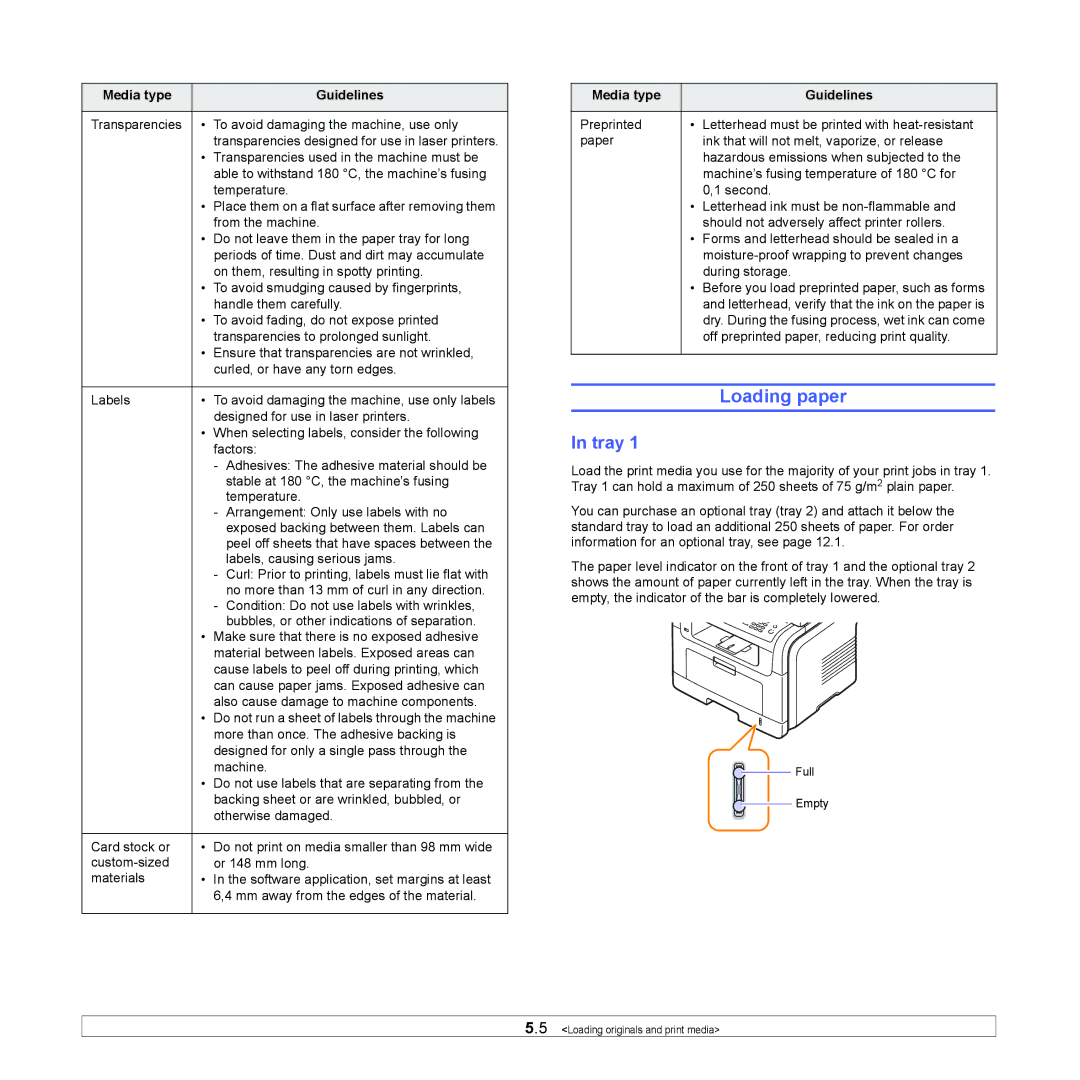
Media type |
|
| Guidelines |
|
|
| |
Transparencies | • | To avoid damaging the machine, use only | |
|
| transparencies designed for use in laser printers. | |
| • | Transparencies used in the machine must be | |
|
| able to withstand 180 °C, the machine’s fusing | |
|
| temperature. | |
| • Place them on a flat surface after removing them | ||
|
| from the machine. | |
| • | Do not leave them in the paper tray for long | |
|
| periods of time. Dust and dirt may accumulate | |
|
| on them, resulting in spotty printing. | |
| • | To avoid smudging caused by fingerprints, | |
|
| handle them carefully. | |
| • | To avoid fading, do not expose printed | |
|
| transparencies to prolonged sunlight. | |
| • | Ensure that transparencies are not wrinkled, | |
|
| curled, or have any torn edges. | |
|
|
| |
Labels | • | To avoid damaging the machine, use only labels | |
|
| designed for use in laser printers. | |
| • | When selecting labels, consider the following | |
|
| factors: | |
|
| - | Adhesives: The adhesive material should be |
|
|
| stable at 180 °C, the machine’s fusing |
|
|
| temperature. |
|
| - | Arrangement: Only use labels with no |
|
|
| exposed backing between them. Labels can |
|
|
| peel off sheets that have spaces between the |
|
|
| labels, causing serious jams. |
|
| - | Curl: Prior to printing, labels must lie flat with |
|
|
| no more than 13 mm of curl in any direction. |
|
| - | Condition: Do not use labels with wrinkles, |
|
|
| bubbles, or other indications of separation. |
| • | Make sure that there is no exposed adhesive | |
|
| material between labels. Exposed areas can | |
|
| cause labels to peel off during printing, which | |
|
| can cause paper jams. Exposed adhesive can | |
|
| also cause damage to machine components. | |
| • Do not run a sheet of labels through the machine | ||
|
| more than once. The adhesive backing is | |
|
| designed for only a single pass through the | |
|
| machine. | |
| • | Do not use labels that are separating from the | |
|
| backing sheet or are wrinkled, bubbled, or | |
|
| otherwise damaged. | |
|
|
| |
Card stock or | • | Do not print on media smaller than 98 mm wide | |
| or 148 mm long. | ||
materials | • | In the software application, set margins at least | |
|
| 6,4 mm away from the edges of the material. | |
|
|
|
|
Media type |
| Guidelines |
|
|
|
Preprinted | • | Letterhead must be printed with |
paper |
| ink that will not melt, vaporize, or release |
|
| hazardous emissions when subjected to the |
|
| machine’s fusing temperature of 180 °C for |
|
| 0,1 second. |
| • | Letterhead ink must be |
|
| should not adversely affect printer rollers. |
| • | Forms and letterhead should be sealed in a |
|
| |
|
| during storage. |
| • | Before you load preprinted paper, such as forms |
|
| and letterhead, verify that the ink on the paper is |
|
| dry. During the fusing process, wet ink can come |
|
| off preprinted paper, reducing print quality. |
|
|
|
Loading paper
In tray 1
Load the print media you use for the majority of your print jobs in tray 1. Tray 1 can hold a maximum of 250 sheets of 75 g/m2 plain paper.
You can purchase an optional tray (tray 2) and attach it below the standard tray to load an additional 250 sheets of paper. For order information for an optional tray, see page 12.1.
The paper level indicator on the front of tray 1 and the optional tray 2 shows the amount of paper currently left in the tray. When the tray is empty, the indicator of the bar is completely lowered.
Full
Empty
5.5 <Loading originals and print media>
